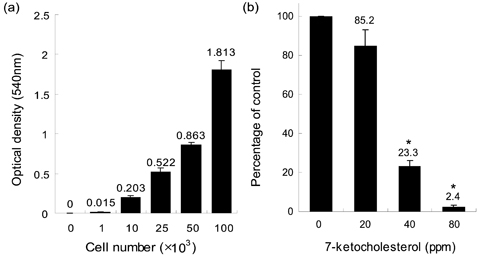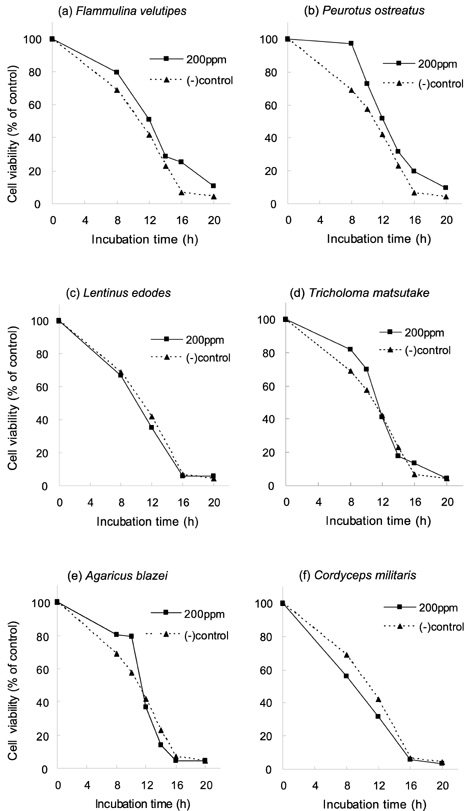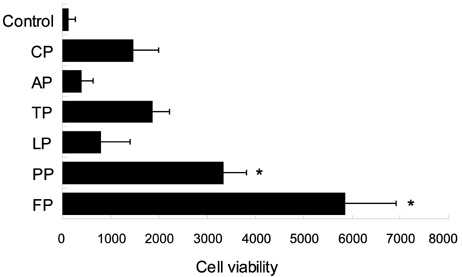Nutr Res Pract.
2007 Sep;1(3):180-183.
Cytoprotective effect of polysaccharide isolated from different mushrooms against 7-ketocholesterol induced damage in mouse liver cell line (BNL CL. 2)
- Affiliations
-
- 1Kwangil Synthesis Plant Co. Ltd., Guro-Gu, Seoul 155-055, Korea. coffee670@naver.com
- 2Department of Biology, Food and Nutritional Sciences Programme, and Food Science Laboratory, The Chinese University of Hong Kong, Shatin, N. T., Hong Kong.
- 3Pulmuone R&D Center, Seodaemun-Gu, Seoul 120-600, Korea.
Abstract
- Cytoprotective ability of polysaccharides isolated from different edible mushrooms was investigated on the 7-ketocholesterol-induced damaged cell line. Polysaccharide extracts from six different edible mushrooms-Flammulina velutipes, Peurotus ostreatus, Lentinus edodes, Agrocybe aegerita, Agaricus blazei, and Cordyceps militaris- were prepared by hot water extraction and alcohol precipitation. Cytoprotective ability was evaluated by measuring the viable cells of the normal embryonic liver cell line (BNL CL. 2) in the presence of 7-ketocholesterol. At 80 microgram/mL of 7-ketocholesterol, cytotoxicity was very high with a loss of 98% of viable cells after 20 h of incubation. With the addition of 200 microgram/mL of each polysaccharide isolate to the cell line containing 80 microgram/mL of 7-ketocholesterol, polysaccharide isolates from both Flammulina velutipes and Peurotus ostreatus could significantly inhibit the 7-ketochoelsterol-induced cytotoxicity in the cells. But other polysaccharide isolates were not effective in inhibiting cell damage caused by the oxLDL-induced cytotoxicity.
Keyword
MeSH Terms
Figure
Reference
-
1. Carmichael J, DeGraff WG, Gazdar AF, Minna JD, Mitchell JB. Evaluation of a tetrazolium-based semiautomated colorimetric Assay: Assessment of chemosensitivity testing. Cancer Res. 1987. 47:936–942.2. Choi MY, Jung TY, Hahm KJ. Cytotoxic effect of hot water soluble poly-saccharides from mushroom: Lentinus edodes and vitamin A, E supplementation against P388 cells. Korean Journal of Nutrition. 1995. 28:1091–1099.3. Ghelli A, Porcelli AM, Zanna C, Rugolo M. 7-ketocholesterl and staurosporine induce opposite changes in intracellular pH, associated with distinct type of cell death in ECV304 cells. Arch Biochem Biophys. 2002. 402:208–217.
Article4. Kewon MH, Jang H, Lim WJ, Chang HI, Kim CW, Yang HC, Hwang HJ, Sung HC. Anti-complementary properties of polysaccharides isolated from fruit bodies of mushroom, Pleurotus Ostreatus. J Microbiol Biotechnol. 1999. 9:450–456.5. Kim J-S, Godber JS, King JM, Prinywiwatkul W. Inhibition of cholesterol autoxidation by the nonsaponifiable fraction in rice bran in aqueous model system. J Am Oil Chem Soc. 2001. 78:685–689.
Article6. Liu F, Ooi VEC, Chang ST. Free radical scavenging activities of mushroom polysaccharide extracts. Life Sci. 1997. 60:763–771.
Article7. Lyons MA, Brown AJ. Molecules in focus: 7-Ketocholesterol. Int J Biochem Cell Biol. 1999. 31:369–375.8. Peng SK, Tham P, Taylor CB, Mikkelson B. Cytotoxicity of oxidation derivatives of cholesterol on culturedarotic smooth muscle cells and their effect on cholesterol biosynthesis. Am J Clin Nutr. 1997. 32:1033–1039.9. Smith LL. Distribution of autoxidaiton properties. Cholesterol Autoxidation. 1981. New York and London. USA: Plenum Press;49–119.10. Sporri S, Chopra V, Egger N, Hawkins HK, Motamedi M, Dreher E, Schneider H. Effect of 5-aminolaevulnic acid on human ovarian cancer cells and human vascular endothelial cells in vitro. Photochem Photobiol. 2001. 64:8–20.11. Woo MS. Studied on antitumor components of Flammulina velutipes of Korea (II). Korean Journal of Mycology. 1983. 11:147–150.
- Full Text Links
- Actions
-
Cited
- CITED
-
- Close
- Share
- Similar articles
-
- Effect of Extracellular Signal-Regulated Kinase Inhibition on Oxysterol 7-Ketocholesterol-Induced Apoptosis
- Nitric Oxide Prevents the IFN-gamma/LPS-induced Hepatocytic Cell Death in a Protein Kinase G-independent Manner
- Inhibitory Effect of Tyrphostin AG126 on Brain Synaptosomal Dysfunction Induced by Cholesterol Oxidation Products
- Radio-protective effect of sulfated polysaccharide purified from Ecklonia cava against small intestinal stem cells of gamma-ray irradiated mice
- Prostaglandin E2 Attenuates 7-Ketocholesterol Toxicity by Suppressing Changes in Mitochondria-Associated Cell Death Process





